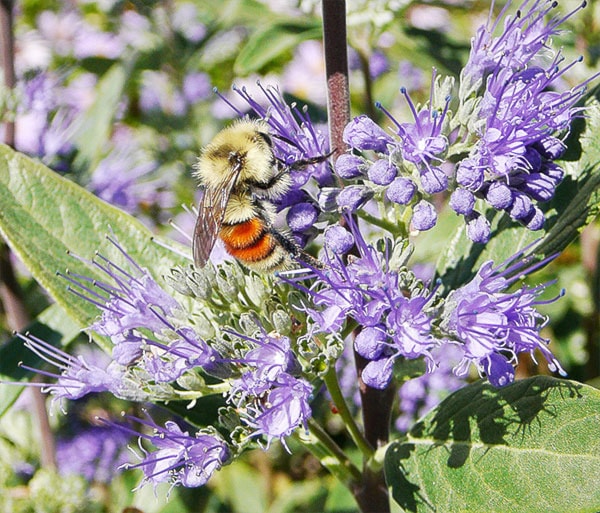Recently, there has been much concern about the escalating death toll in bee colonies around the world.
There’s less honey for our breakfast toast, but far more concerning is the fact that much of our food supply relies on pollination by bees.
Seventy-five per cent of all plant species are dependent on pollinators.
In return for pollination, flowers supply the pollinators with nectar for energy and pollen for protein.
Native bee populations are also in severe decline which affects the survival of native plants as well as the potential for native bees to pollinate our food plants.
In a recent Border Free Bees lecture, Dr. Ralph Carter indicated there are many hypotheses about the cause of the decline in wild bees including habitat loss and fragmentation, pesticides and encroachment of mono crop agriculture.
Studies have shown that urban areas are an oasis for native pollinators. Our gardens have high densities of flowering plants and low/no levels of pesticides.
Everyone growing flowers can do something to help pollinators.
Bees are most attracted to blue and, second, to yellow.
Really good blue-flowered, extremely drought-tolerant plants for pollinators include catnip varieties (Nepeta), lavender, Russian sage (Perovskia) and sage (herb).
With some supplemental water, Aster frikartii’s blue flowers, bloom from July to frost and Caryopteris ‘Dark Knight,’ a small shrub, has vibrant blue flowers in August and September.
There are many very drought-tolerant yellow flowers for pollinators.
Some with the longest blooming period are Missouri evening primrose (Oenothera macrocarpa) and varieties of: tickseed (Coreopsis), blanket flower (Gaillardia), yarrow (Achillea), and the annual, calendula.
Yellow flowered Okanagan native shrubs are Oregon grape (April), rabbitbrush (August, September)
To find many more water-wise plants that attract pollinators, use the plant database at okanaganxeriscape.org.
Next week there are two excellent presentations on our native bees.
Wednesday, April 6, �������� Garden Club guest speaker, Master Gardener Fearon Blair, will present “Gardening with Pollinators,” 7 p.m., at First Lutheran Church, 4091 Lakeshore Rd. All are welcome. ($2 for non members)
Thursday, April 7, Elizabeth Elle, SFU biology professor will present: “Save the Wild Bees: How They Help Produce Our Food, and How You Can Help in their Conservation” at the downtown �������� library, 1380 Ellis St.),7 to 8:30 p.m. (see story on A24). Free Admission, pre-register at pollinizingsessions-elle.eventbrite.ca/ to save yourself a seat.
***
My two-night xeriscape classes are filling up fast but there is still space for the Thursday sessions, April 14 and 21, or Wednesdays, May 4 and 11, from 7 to 9 p.m., at the St Michael and all Angels Cathedral Hall, 608 Sutherland Ave. in ��������.
Cost is $50/ person or $90/couple from same household.
For more information and to register, go to the classes page at okanaganxeriscape.org or call 250-762-6018.
And mark your calendars for Saturday April 30, when the Okanagan Xeriscape Association’s annual Xeriscape Plant Sale will be held in the unH2O Garden, 4075 Gordon Dr., in front of the H2O Aquatic Centre from 9 a.m. to noon.



